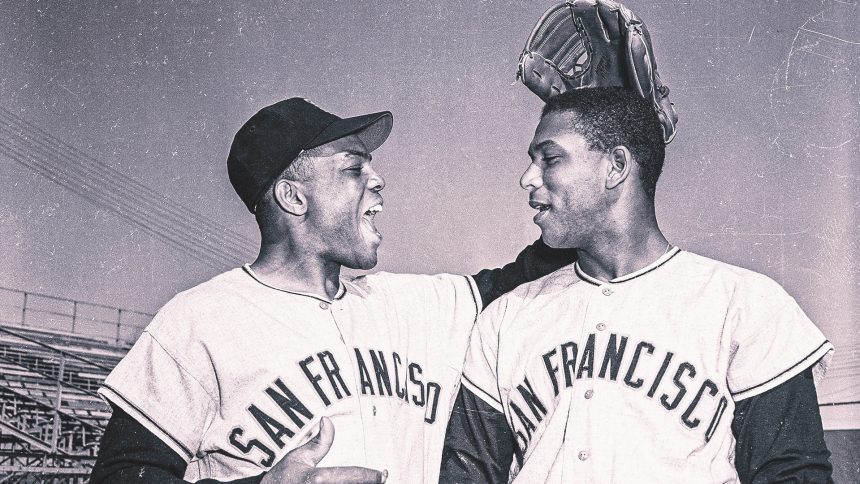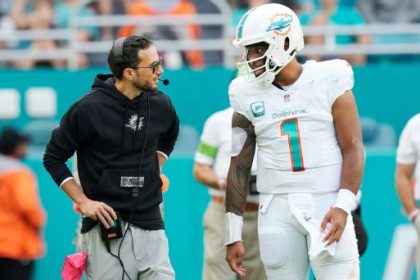Long after “The Catch” and his 660 home runs, and the daring sprints around the bases with his hat falling off, Willie Mays could still command a room like no other.
Mays was a frequent visitor to the downtown ballpark in San Francisco at 24 Willie Mays Plaza with his statue outside the stadium. He would often hold court with his contemporaries and the younger generation of players who hung on every word said by a player they were too young to have ever watched play.
His commanding voice and high-pitched laugh were recognizable anywhere. He was simply the “Say Hey Kid” from his days patrolling center field at the Polo Grounds in the 1950s, when baseball ruled New York City, to his death at age 93 on Tuesday afternoon.
As Hall of Famer Ken Griffey Jr. said: “He’ll always be the godfather of all center fielders.”
ADVERTISEMENT
There may be players who hit more home runs, won more Gold Gloves, had more hits and captured more World Series titles than Mays. But there never was — and probably never will be — a player as dazzling and entertaining as he was for more than two decades on both coasts.
With a hat too small so it flew off his head as he raced around the field and his signature basket catches, Mays was a showman who could do it all as the consummate “five-tool player.” Perhaps no one combined the ability to hit for both average and power, to run the bases, field and throw like Mays did during his career spent mostly with the Giants in New York and San Francisco.
“Willie could do everything from the day he joined the Giants,” Hall of Fame manager Leo Durocher said. “Mays could do all the things you look for in a player better than anybody I ever saw.”
While Joe DiMaggio famously insisted on being introduced as the “Greatest Living Ballplayer” until he died in 1999, that title had really been held by Mays for more than a half-century.
The numbers are staggering: 660 homers, 3,293 hits, 6,080 total bases, 2,068 runs scored, two MVPs, and 24 All-Star games despite missing nearly two full seasons serving in the Korean War. There were also 12 Gold Gloves even though the award wasn’t even handed out his first five seasons in the majors.
RELATED: Willie Mays: An incomparable career by the numbers
But it was his joy that truly was infectious and inspiring, whether it was on the streets of Harlem where he famously played stick ball games with local kids before heading to the nearby Polo Grounds for his real job with the Giants or at the ballparks around the National League.
“You wanted to play like Willie and make those catches that he did,” Yankees slugger Aaron Judge said. “The numbers he put up on the field and what he did are impressive but him as a person and him as a human being is even bigger. He was bigger than baseball. He was something special and the baseball world is definitely going to be missing a great one.”
His greatness is best described by the reverence his contemporaries had for him.
“He played the game as if he was the only one out there,” Hall of Famer Ernie Banks once said. “His eyes would light up. His energy would kick in and he’d be ready to go. I had the privilege of watching and playing against a great talent.
“He played so hard, it inspired me to get out there every game. I couldn’t wait to play the Giants and watch him.”
Mays’ ability to inspire went far beyond the baseball field. He was born in 1931 in segregated Alabama, began his professional career in the Negro Leagues and became one of the early Black stars in baseball and the first Black player in the majors to be captain of his team.
But he also endured racism from his time in the minors in the previously all-white Interstate League and in San Francisco when he and his wife were initially rejected when they tried to buy a house in an exclusive neighborhood.
But later in life, he became almost universally loved.
RELATED: Sports world reacts to Willie Mays’ death, reflects on baseball legend’s legacy
“It’s because of giants like Willie that someone like me could even think about running for president,” President Barack Obama said when he gave Mays the Presidential Medal of Freedom in 2015.
Mays played his career when baseball truly was the American pastime and baseball’s best players were the biggest stars in all of American sports.
He was honored in song from Terry Cashman’s “Talkin’ Baseball (Willie, Mickey & The Duke)” that remembered the great New York center fielders of the 1950s with Mays, Mickey Mantle and Duke Snider to the 1955 classic by The Treniers: “Say Hey (The Willie Mays Song) that perfectly encapsulated his style.
“He runs the bases like a choo-choo train
Swings around second like an aeroplane
His cap flies off when he passes third
And he heads home like an eagle bird.”
Reported by The Associated Press.
[Want great stories delivered right to your inbox? Create or log in to your FOX Sports account, follow leagues, teams and players to receive a personalized newsletter daily.]
recommended

Get more from Major League Baseball Follow your favorites to get information about games, news and more













